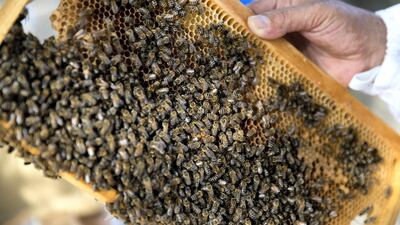Mohammed Saeed is just 20 years old and has already seen the effects of climate change on the most valuable resource in his village, its honey.
“The weather’s not good and the bees are dying with the heat,” he said. “Cold is good for bees and it’s gotten hot.”
Mr Saeed has collected honey on the green terraced cliffs of Jebel Habashi in southwest Yemen since he was 12. “In the last four years, it’s gotten bad,” he said. “The weather has changed.”
In addition to climate change, bees in the Gulf face invasive species, habitat degradation, parasitic mites and killer fungi. To tackle these challenges, the Arab Beekeepers Co-operative Association launches next week at the Global Forum for Innovations in Agriculture in Abu Dhabi. The new association will be bring together scientists, honey traders and beekeepers to find environmental and trade solutions to regional problems.
“It’s time to have something for the Arab beekeepers,” said Ahmed Al Ghamdi, the association’s chair and supervisor of the bee research chair at Riyadh’s King Saud University. “Everyone is working by themselves but we’re hoping that this Arab beekeeping association will unite the people and build co-operation between us.”
The first International Conference of the Arab Beekeeping Organisation will be held on February 5 at Abu Dhabi National Exhibition Centre.
About 2,000 beekeepers and scientists have already signed up for membership. Elected representatives will meet regularly.
It is not a first. In 1994, Mr Al Ghamdi helped establish Arab Beekeepers Union and served as chief of its bee unit.
This time, it’s different. There are more stakeholders, there is more governmental support and more urgency. Nearly 25 years later, the impending disappearance of bees from our planet has raised international alarm. Fears of an agricultural armageddon have even prompted Japanese scientists to create robotic replacements, miniature drones covered in animal hair and ionic liquid gel.
In the Arabian Peninsula, as elsewhere, bees face threats from the macro to the microscopic.
In northern Yemen, bees are being killed off from pesticides used on khat, a narcotic shrub. “Farmers want profit,” said Ishaq Saeed, a honey producer from the Taiz region. “This is our biggest problem and if we got rid of khat, the bees wouldn’t die.”
_____________
Read more:
Honey Bee Deaths tip of iceberg
Making a beeline for liquid gold in the Northern Emirates
WATCH: The UAE honey farm that ships billions of bees around the world
_____________
In western Yemen, Saddam Al Jabberi lost 700 of his 1,000 colonies in Hadramaut last summer. He blames an unusually extreme summer.
“Haudramaut is getting hotter, hot like Abu Dhabi,” said Mr Al Jabberi, who heads a cooperative of 26 honey producers and manages a honey shop in Baniyas.
Closer to home, farmers on the Saiq plateau of Oman's Jebel Al Akhdar have suffered from a series of mild winters and water shortages that crippled harvests. In Ras Al Khaimah and Fujairah, elders say the pollen trails of bees that once dotted the mountains have vanished. In majlises, their generation is not shy to point the finger at pollution caused by quarries, cement factories and urbanisation.
Despite this, honey remains good business, fetching hundreds of dirhams per kilogram. Mr Saeed’s family shop in Abu Dhabi sells an monthly average of 200 kilograms worth Dh45,000.
Saudi Arabia has more than 14,000 beekeepers and that number is growing quickly, said Mr Al Ghamdi. Its estimated one million colonies produce an estimated 9,000 tonnes of honey annually.
“We have our local bees but last year we important 700,000 bees, mainly from Egypt,” he said. “Here the in Emirates they imported 450,000 bees. We are still importing and hopefully if we work well in the future we will be producing [bees] ourselves.”
This comes at a cost. Imported subspecies are breeding with the small, indigenous Apis mellifera jementica.
“Before we used to have two or three beekeepers in one location,” said Mr Al Ghamdi. “Now we have 100 beekeepers in one location and they are competing for the same source of nectar.
“These imported bees, they attack our local bees. Unfortunately, imported bees have replaced the local bees. In recent years because the genetics of our local bees have become affected.”
Mr Saeed welcomed the news of a regional association, noting that any regional framework to protect bees would be beneficial. “The most important thing in my village and the rural mountains is honey. Honey brings money.”

